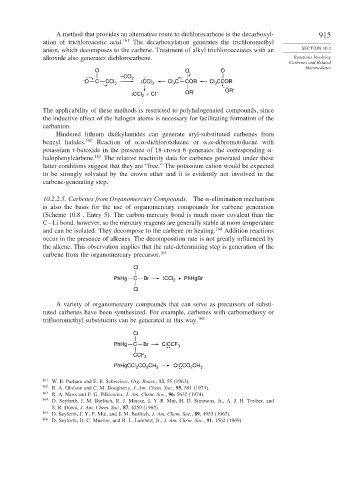Page 939 - Advanced Organic Chemistry Part B - Reactions & Synthesis
P. 939
A method that provides an alternative route to dichlorocarbene is the decarboxyl- 915
ation of trichloroacetic acid. 161 The decarboxylation generates the trichloromethyl
anion, which decomposes to the carbene. Treatment of alkyl trichloroacetates with an SECTION 10.2
alkoxide also generates dichlorocarbene. Reactions Involving
Carbenes and Related
Intermediates
O O O
–CO –
– O C CCl 3 2 :CCl 3 Cl C COR Cl CCOR
3
3
–
:CCl +Cl – OR' OR'
2
The applicability of these methods is restricted to polyhalogenated compounds, since
the inductive effect of the halogen atoms is necessary for facilitating formation of the
carbanion.
Hindered lithium dialkylamides can generate aryl-substituted carbenes from
benzyl halides. 162 Reaction of , -dichlorotoluene or , -dibromotoluene with
potassium t-butoxide in the presence of 18-crown-6 generates the corresponding -
halophenylcarbene. 163 The relative reactivity data for carbenes generated under these
latter conditions suggest that they are “free.” The potassium cation would be expected
to be strongly solvated by the crown ether and it is evidently not involved in the
carbene-generating step.
10.2.2.5. Carbenes from Organomercury Compounds. The -elimination mechanism
is also the basis for the use of organomercury compounds for carbene generation
(Scheme 10.8 , Entry 5). The carbon-mercury bond is much more covalent than the
C−Li bond, however, so the mercury reagents are generally stable at room temperature
and can be isolated. They decompose to the carbene on heating. 164 Addition reactions
occur in the presence of alkenes. The decomposition rate is not greatly influenced by
the alkene. This observation implies that the rate-determining step is generation of the
carbene from the organomercury precursor. 165
Cl
PhHg C Br :CCl + PhHgBr
2
Cl
A variety of organomercury compounds that can serve as precursors of substi-
tuted carbenes have been synthesized. For example, carbenes with carbomethoxy or
trifluoromethyl substituents can be generated in this way. 166
Cl
PhHg C Br ClCCF 3
:
CCF 3
PhHgCCl CO CH 3 ClCCO CH 3
2
2
2
:
161 W. E. Parham and E. E. Schweizer, Org. React., 13, 55 (1963).
162
R. A. Olofson and C. M. Dougherty, J. Am. Chem. Soc., 95, 581 (1973).
163
R. A. Moss and F. G. Pilkiewicz, J. Am. Chem. Soc., 96, 5632 (1974).
164 D. Seyferth, J. M. Burlitch, R. J. Minasz, J. Y.-P. Mui, H. D. Simmons, Jr., A. J. H. Treiber, and
S. R. Dowd, J. Am. Chem. Soc., 87, 4259 (1965).
165 D. Seyferth, J. Y.-P. Mui, and J. M. Burlitch, J. Am. Chem. Soc., 89, 4953 (1967).
166
D. Seyferth, D. C. Mueller, and R. L. Lambert, Jr., J. Am. Chem. Soc., 91, 1562 (1969).

